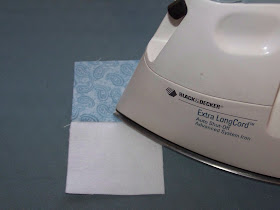Lesson 2 -- Fabric
Lesson 3 -- Cutting Fabric
If you have made it this far in the quilting process, congratulations! You are now ready to begin sewing your pieces together!
Before you begin piecing, you need to gather a few supplies -- a sewing machine, thread, an ironing board, an iron, and some pins. Let's take a moment to talk about these supplies and a few of the basic techniques of piecing.
THREAD
It is best to use thread that is 100% cotton, however it is not absolutely necessary. What you should NOT use is thread that is very old (ie grandma's old thread). For more on the best thread to use for quilting, check out this page about thread.
The color thread you use depends on the fabrics you are sewing. I typically either use white or natural (light tan) colored thread when piecing. For the most part, the thread will not be seen, so it is not necessary for it to match exactly. What you want to stay away from is using a very light thread to piece dark fabrics or a very dark thread to piece very light fabrics.
SEWING MACHINE
Sewing machines can vary quite significantly in style and age. You know your machine best. Make sure your machine settings, tension, and needle are appropriate for the type of fabric you are sewing. For information about sewing machine needles, check out this page about machine needles. In addition, you should equip your machine with a 1/4" presser foot.
SEAM ALLOWANCE
As with cutting, accuracy is the name of the game when it comes to piecing. Be sure you are sewing using a 1/4" seam allowance. For more about accurate piecing techniques, I would highly recommend taking the time to check out this page about piecing accurately.
PRESSING
After you sew your fabric, you will need to press your seams with an iron. It is very easy to stretch and distort your fabric by pressing incorrectly. Here is a great page with tips on how to press seams.
So, now that you know the basics, let's get started piecing our quilt!
Start by laying out the nine squares for your first nine-patch block.
 |
| Lay out the squares for your first nine-patch block as shown. |
Pick up the second square in the first row and flip it over (right side down) on top of the first square in that same row.
Line up the edges and sew them together along the right side, using a 1/4" seam allowance.
After sewing, open the two-piece unit and put it face-up on your ironing board. Using a pre-heated iron set to a cotton setting, press the seam toward the darker fabric (in this case, the blue fabric).
Repeat this process for the second and third rows. Then lay the pieced units out as shown in the photo at left.
Now take the third square in each row and flip it over so the right side is facing down on top of the middle square. Stitch each seam with a 1/4" seam allowance. Press all seams toward the darker fabric.
Now you are ready to sew your rows together. Lay them out in the order they will be in the block (see photo at left).
Pick up the top row and flip it face-down on top of the second row. At this point, it is very important that you carefully line up the previously sewn seams.
If you did your pressing correctly, the seams should "nest" nicely, as shown in this photo. Pin each seam after you check that it is lined up.
Use a 1/4" seam allowance to sew the rows together.
When you open the pieced unit, it should look like this. Notice how all the corners of the squares meet up perfectly. There is no overlap.
This is what you are striving for.
It may seem a little time consuming to line up each seam, but if you sew the rows together without doing this step, the squares in your block will not line up and will result in a "messy" and amateur looking block (in my opinion).
In the same manner as you just sewed rows 1 and 2, sew row 3 to row 2.
Congratulations!
You have just completed your first nine-patch block. Way to go!
 |
Press all the seams you just sewed in the same direction. I pressed mine all going toward the bottom of the block. It doesn't matter which way you choose. Just be consistent with all your blocks.
One last step that I would recommend is to take the time to square-up your finished block. A square ruler is very helpful for this task, but certainly not necessary.
If you look at the lines for 6 1/2" on this ruler, you will notice that the pieced block isn't perfectly square.
The goal is to get the finished block to be as close to 6 1/2" as possible.
 |
| Use a rotary cutter to trim your blocks |
The more accurately you can size your finished blocks, the more easily everything will fit together as you piece the top of your quilt.
 |
| Finished nine-patch block -- make 18 total for quilt top. |
Repeat these steps to make all 18 nine-patch blocks.
In Lesson 5, we will begin piecing the blocks into rows with the plain block squares to complete the quilt top.










No comments:
Post a Comment